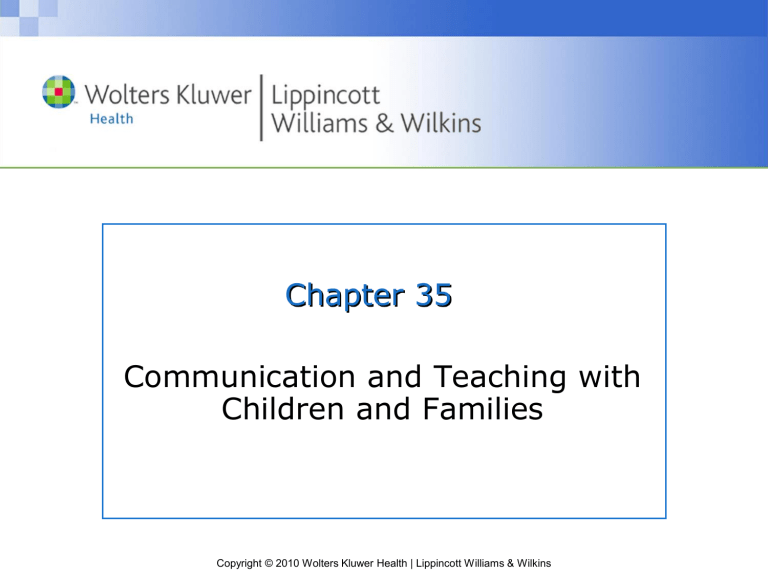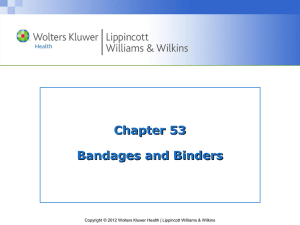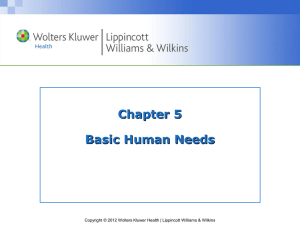Airgas template

Chapter 35
Communication and Teaching with
Children and Families
Copyright © 2010 Wolters Kluwer Health | Lippincott Williams & Wilkins
Nursing Process: Health Teaching
• Assessment
• Nursing diagnosis
• Outcome identification, planning
• Implementation
• Outcome evaluation
Copyright © 2010 Wolters Kluwer Health | Lippincott Williams & Wilkins
Communication
• Nontherapeutic
• Therapeutic
• Components
– Encoder
– Code
– Decoder
– Feedback or response
Copyright © 2010 Wolters Kluwer Health | Lippincott Williams & Wilkins
Communication (cont’d)
• Development of language
• Levels of communication
– First level
– Second level
– Third level
– Fourth level
– Fifth level
Copyright © 2010 Wolters Kluwer Health | Lippincott Williams & Wilkins
Communication (cont’d)
• Nonverbal
– Distance
– Genuineness
– Warmth
– Empathy
– Gestures
Copyright © 2010 Wolters Kluwer Health | Lippincott Williams & Wilkins
Communication (cont’d)
• Nonverbal
– Body posture, gait
– General appearance
– Touch
– Humor
– Drawings
– Music
Copyright © 2010 Wolters Kluwer Health | Lippincott Williams & Wilkins
Communication (cont’d)
• Therapeutic communication
– Attentive listening
– Open-ended questions
– Reflecting
– Clarifying
– Paraphrasing
Copyright © 2010 Wolters Kluwer Health | Lippincott Williams & Wilkins
Communication (cont’d)
• Therapeutic communication
– Perception checking
– Focusing
– Supportive statements
– Silence
– Process Recording
Copyright © 2010 Wolters Kluwer Health | Lippincott Williams & Wilkins
Factors Interfering with Communication
• Age, developmental level
– Intellectual level
– Physical factors
– Technical terminology
– Showing disapproval
Copyright © 2010 Wolters Kluwer Health | Lippincott Williams & Wilkins
Factors Interfering with Communication
(cont’d)
• Age, developmental level
– Not showing approval when warranted
– Being defensive
– Cliché advice
– Topping off
Copyright © 2010 Wolters Kluwer Health | Lippincott Williams & Wilkins
Factors Interfering with Communication
(cont’d)
• Special communication skills
– Shy child
– Angry child
– Demanding child
– Sexually aggressive adolescent
– Child who is not English proficient
Copyright © 2010 Wolters Kluwer Health | Lippincott Williams & Wilkins
Factors Interfering with Communication
(cont’d)
• Special communication skills
– Unconscious child
– Hearing-challenged child
– Vision-challenged child
Copyright © 2010 Wolters Kluwer Health | Lippincott Williams & Wilkins
Health Teaching
• Art of teaching
– Teacher-learner relationship
• Art of learning
– Types of learning
• Influence of age, stage
Copyright © 2010 Wolters Kluwer Health | Lippincott Williams & Wilkins
Teaching Plan
• Areas of assessment
– Language level
– Current knowledge
– Intellectual capability
– Physical capabilities
– Psychological or emotional capabilities
Copyright © 2010 Wolters Kluwer Health | Lippincott Williams & Wilkins
Teaching Plan (cont’d)
• Areas of assessment
– Sociocultural values
– Attention span
– Lifestyle
– Learning style
Copyright © 2010 Wolters Kluwer Health | Lippincott Williams & Wilkins
Teaching Plan (cont’d)
• Formulating the plan
– Identifying personal strengths, limitations
– Preparing expected outcomes
– Identifying teaching formats
Copyright © 2010 Wolters Kluwer Health | Lippincott Williams & Wilkins
Teaching Plan (cont’d)
• Teaching strategies
– Lecture
– Demonstration
– Redemonstration
– Discussion
– Role modeling
– Behavior modification
Copyright © 2010 Wolters Kluwer Health | Lippincott Williams & Wilkins
Teaching Plan (cont’d)
• Teaching tools
– Visual aids
– Pamphlets
– Learning games
– Videotapes, slides, films
– Puppets, dolls
– Health fairs
Copyright © 2010 Wolters Kluwer Health | Lippincott Williams & Wilkins
Teaching Plan (cont’d)
• Implementing the plan
– Resource people
– Parent education
• Evaluating effectiveness of teaching
Copyright © 2010 Wolters Kluwer Health | Lippincott Williams & Wilkins
Question
• A 10-year-old girl is newly diagnosed with diabetes. The nurse plans to teach her about nutrition related to her diagnosis. The best approach for this child would be to
A.
play a diabetic nutrition trivia game with her.
B.
show her a video about meal planning.
C.
give her a list of foods she cannot have.
D.
have the doctor teach her this information.
Copyright © 2010 Wolters Kluwer Health | Lippincott Williams & Wilkins
Answer
• A. Play a diabetic nutrition trivia game with her.
• Rationale: Learning through play is a valuable tool at this age. She may be bored by a video. Giving her a list of what she cannot have is a negative approach. This teaching is within the scope of the nurse.
Copyright © 2010 Wolters Kluwer Health | Lippincott Williams & Wilkins
Question
• Preschool children tend to “center” on information. This means that they
A.
learn only the middle part of a procedure.
B.
may concentrate on one part of a procedure and appear not to hear another.
C.
have to have printed material directly in front of them to understand it.
D.
do not retain information longer than a week.
Copyright © 2010 Wolters Kluwer Health | Lippincott Williams & Wilkins
Answer
• B. May concentrate on one part of a procedure and appear not to hear another
• Rationale: To center means to concentrate on only one characteristic of an object or event (seeing a banana is yellow, but not long).
Copyright © 2010 Wolters Kluwer Health | Lippincott Williams & Wilkins






